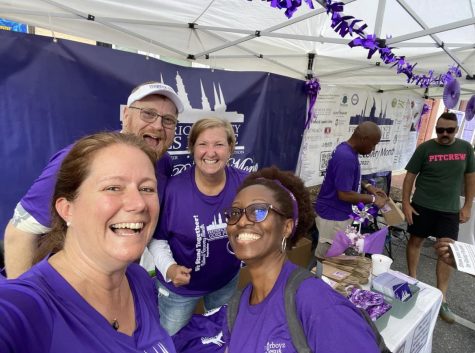Maryland schools hit hard by the opioid crisis: How are FCPS and the Frederick community responding?
Nalaxone Nasal Spray(Narcan), which is used to reverse the effects of an opioid overdose, can be found in the Linganore High School (LHS) Health Room.
March 23, 2023
An opioid epidemic is tearing its way across the nation, and Maryland schools have been caught in its grip.
In fact, this nationwide crisis is not a new development and has worsened in recent years. Opioid-related deaths in the United States have been increasing steadily since 2010, and the anxiety and isolation brought on by the COVID-19 pandemic made overdoses skyrocket in 2020, a 31% rise from 2019.
Opioids are a broad group of drugs that interact with the opioid receptors in brain cells to release endorphins-chemicals in the brain that decrease pain and increase feelings of pleasure. These substances are highly addictive and often extremely fatal. In 2022 alone, 80,000 overdose deaths in the United States were recorded as opioid-related.
The most well-known opioids are those given as prescription drugs, such as oxycontin and morphine. These substances can be used as pain relievers for recovering surgical patients or to treat chronic conditions. Due to their addictive qualities, the majority of opioid overdoses initially resulted from the abuse of these prescribed medications.
But recently, communities across the nation are being confronted with a different, more fatal opioid: fentanyl. There are two types of the drug currently contributing to the opioid crisis: pharmaceutical and illicitly manufactured fentanyl.
The primary type of fentanyl used in the United States was prescribed by doctors for severe pain management, typically for those with advanced-stage cancer. When intended for medical use, fentanyl is not easily acquired; the drug is prescription only, and is given as a shot, patch or lozenge, rather than the pill or powder form it takes in the illicit drug market.
While pharmaceutical fentanyl is kept under tight control, the opioid is a synthetic drug, which makes it incredibly easy to illegally manufacture.
Due to its high potency and how cheap it is to fabricate, fentanyl is often mixed with drugs such as heroin and cocaine or made into pills that resemble other prescription opioids.
These fentanyl-laced pills are becoming increasingly prominent in the nation’s drug market. According to testing done by the U.S. Drug Enforcement Administration, “six out of ten [laced prescription pills] now contain a potentially lethal dose of fentanyl.”
Frederick County has been hit particularly hard by the fentanyl crisis. According to the most recent Community Health Needs Assessment report, 56 of the 64 overdose related deaths in 2020 were caused by fentanyl.
One might think that the prominence and lethality of fentanyl might have led to a hyper awareness surrounding the drug. Unfortunately, however, fentanyl is virtually undetectable when mixed with other substances or laced in a pill, so many who overdose have no idea they are ingesting the drug.
One group that has been heavily impacted by the fentanyl crisis is school-age adolescents, and the issue hits much closer to home than many realize.
In neighboring Montgomery County Public Schools (MCPS), youth overdoses increased by 77% from 2021 to 2022.
According to data from the Montgomery County Police Department, there were 48 overdoses in people under 21 in 2022. Unfortunately, 11 of those overdoses were fatal. Additionally, just weeks ago, in nearby Arlington County, Virginia, a student died as a result of a fentanyl overdose at school.
If an overdose were to happen at an FCPS school, it would be imperative that someone with Narcan training and access reach the student as quickly as possible.
Narcan, also known as Naloxone, is a nasal spray that is used to reverse the effects of an opioid overdose. In situations where emergency medical help is not immediately available, Narcan training and availability can mean the difference between life and death.
Therefore, it may surprise some to learn that the only faculty in FCPS school buildings with access to Narcan are health technicians or school nurses.
Linganore High School Assistant Principal Erik Engelstatter said that while administrators are trained in CPR, they are not trained on how to administer Narcan, nor do they carry it with them.
“We don’t have Narcan training [at Linganore],” Engelstatter said. “This pouch on my lanyard is a CPR kit, which we [administration] are all certified in, but the only one who carries Narcan is the health technician.”
The health technician at Linganore, LeAnn Windsor, has an Opioid Overdose Kit attached to her bag, which goes with her everywhere.
“This [kit] is attached to my health bag at all times,” Windsor said. “It has everything in it we would use to treat a potential overdose. Narcan is always in there.”
The importance of Narcan in overdose situations cannot be overstated. According to the National Institute on Drug Abuse, opioid overdose deaths decreased by 14% in states which enacted naloxone access laws.
Despite the knowledge that school staff are prepared to deal with an overdose, many people still wonder how students are gaining access to these dangerous substances in a school environment.
There has only been one overdose in FCPS in the last five years, but the use of vape and marajuana pens–which are often laced with fentanyl–has been an ongoing issue for administrators across the county.
Engelstatter says that the bathrooms are a big contributor to the problem.
“Students are in the bathrooms vaping and using dab pens that are laced, and that leads to medical situations,” said Engelstatter. “It’s why we go so hard about the bathrooms.”
There is no question that this is a dire situation, but thanks to the efforts of school systems and organizations throughout the state, the Frederick community is becoming prepared to better address this issue.
With the help of local organization Frederick County Goes Purple, FCPS held a Purple Certification training event and resource fair at Frederick High School on Wednesday, Feb. 15.
Purple Certification training is a course offered to schools and businesses in order to educate people on how to safely and intelligently care for those dealing with addiction or in recovery.

The organization Frederick County Goes Purple, which provides the training, was created by husband and wife Carol and Jon Switzer in 2018 after the pair noticed an issue with addiction in the Frederick area.
“This [opioid addiction] is one of the biggest issues in our area,” said co-founder Carol Switzer. “People are dying every week.”
When discussing the Purple Training program, Switzer emphasized the importance of educating the community on substance abuse and how to care for people fighting addictions.
“We want people to be able to lean in when they hear that somebody has a problem,” Switzer said. “We find with this kind of training … even students can take away nuggets and understand how to walk alongside someone and show them love.”
Both Switzer and Engelstatter stressed that the most important thing students can do to prevent overdoses is communicate.
“Communication is the biggest thing,” said Engelstatter. “Everyone is so worried about being a ‘snitch,’ but by speaking up, you’re potentially saving somebody’s life. If you see something, say something.”
Anyone interested in receiving Narcan training through the Frederick County Government can click here.






